Newsletter March 2021
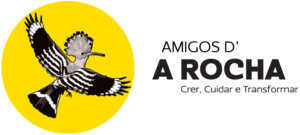
 Welcome to our March Newsletter.
Welcome to our March Newsletter.
We hope you enjoy this month articles.
Spring is coming! Happy Spring!
Helen & Filipa
S
N
A
P
SHOT

Sebastian I

16th King of Portugal (1557-1578)
Born: 20th January 1554, Lisbon
Died: 4th August 1578, Alcácer Quibir, Morocco
Sebastian I, ascended to the throne very young, he was only 3 years old. Son of João Manuel, Prince of Portugal (1537-1554) and Joana of Austria; he was the grandson of John III, King of Portugal (1502-1557). Due to his young age, he was unable to reign so it was decided there should be a Regent. The first Regent was his grandmother, the Queen Catarina of Austria, followed by his grand uncle the Cardinal Henry of Évora.
Sebastian was named “The desired one”, he was the salvation of the Portuguese Crown; all the children of his grandfather, King John III died very young, except his father (João Manuel) who reached adolescence and got married when he was 15 years old, he died before his son’s birth. Maria Manuela of Portugal (1525-1545), sister of João Manuel, who married Felipe II, King of Spain, with the condition that if there weren’t any direct succession to the Portuguese crown, their children would inherit it. Everyone waited anxiously the birth of the new successor.
The education of Sebastian I, was both military and religious, he was an intelligent man and an enthusiast of dangers and adventures; when he was 14 years old it was declared by a majority that he was able to started to reign alone. During this period the colonial expansion was stopped, and the main aim was to protect and strengthen the colonies Portugal already had. The colonies in North Africa were very expensive and not very important from a commercial and strategic point of view. North Africa was now in the hands of the Turkish and they were trying to get Morocco; the Moors of Morocco asked Sebastian for help and he decided to initiate the “African Journeys”.
On the 4th of August was the start of the Alcácer Quibir battle or the battle of the 3 kings (because supposedly 3 kings died during it); the story tells the battle lasted for 4 hours and victory was never declared. King Sebastian disappeared in the middle of the crowd (or fog) and was never seen again, his body was never found. The story became a legend and since then the Portuguese wait for the return of their King on a foggy day to help the country.
IFO’s – Identified Flying Objects…

Cucullia calendulae, Treitschkle, 1835

Morphology: It is a macro moth from the Noctuidae Family, with a wingspan between 41 to 46 mm. The forewings are streaked grey and the hind wings are pale grey with dark veins. Rests with wings closed tightly against body, with collar raised into a pointed projection (resembling a shark dorsal fin). The adults fly from November to April. One generation per year.
Habitat: ruderal areas, roadsides, fields, coastal dunes and bushlands.
Distribution: Mediterranean basin, Southern Europe, Northern Africa to the Middle East.
Notes: The larvae feed on Asteraceae, especially Calendula species, but also Ormenis, Archillea and Anthemis; it can feed on all parts of plant (stems, leaves, buds and flowers). The caterpillars live usually in spring and the pupa aestivates to survive the drought period of summer.
Tweet… Tweet…

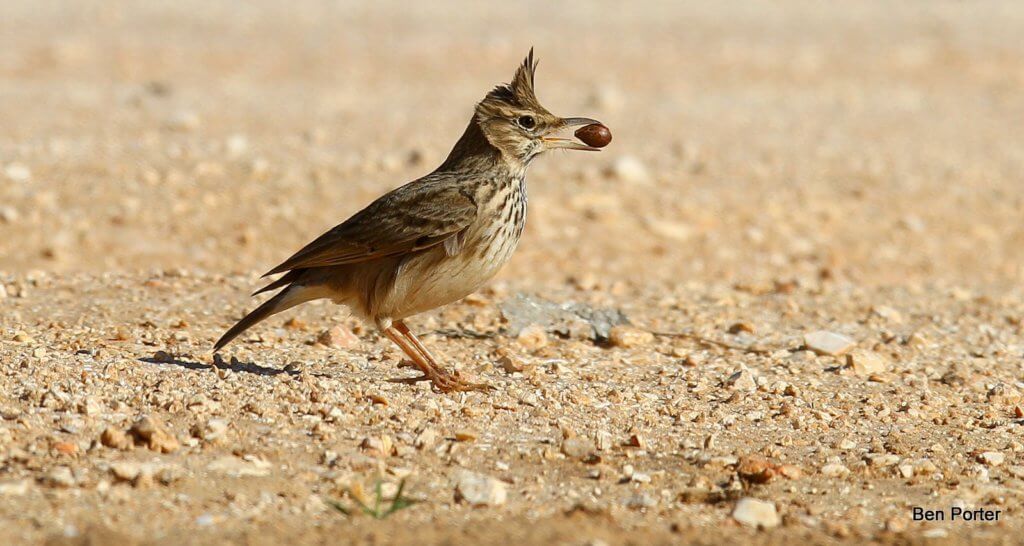
Crested Lark (Galerida cristata, Linnaeus, 1758)
Identification: It’s a passerine from the Alaudidae Family up to 18 cm of length. The plumage is brownish in the back and wings, underneath the wings its reddish; the belly is whitish and the breast pale with dark stripes, the tail is short; long and pointed crest; the bill is long and slightly curved. The juveniles have smaller crests.
Habitat and Ecology: Inhabits open country areas, fallow lands, wastelands, roadsides, dunes, arable crops and farmlands. The diet consists mainly of seeds and small invertebrates (like beetles).
Distribution: Native from Europe, North Africa and Asia. In Portugal it is present all over the country but is more common in the centre and south. This species is mainly resident.
Threats: Least Concern (LC) in the International Union for Conservation of Nature (IUCN) red list. The population has been decreasing due to intensive agriculture. There are several subspecies according to their distribution, in Portugal the Iberian Crested Lark is present (G. cristata pallida). This specie is very similar to Thekla Lark (Galerida theklae).
DID YOU KNOW? 
- A PhD student from Cardiff University, Hannah Hereward (Newsletter July 2018) is working on a remote islet in the Azores. She was volunteer on the Storm Petrel Project at A Rocha together with Ben Porter (Newsletter March 2019) who produced the following video. Amazing place!
- Spring is here! Slowly all our summer visitors are arriving, the first ones were the House Martins (Delichon urbicum), the Barn Swallows (Hirundo rustica) and the Red-rumped Swallows (Cecropis daurica)!
- Spring is also the best time to see butterflies! They can surprise us with colours and sizes, like this amazing Provence Hairstreak (Tomares ballus)! And of course, the flowers are blooming! Some start before Spring, like this amazing Petticoat Daffodil (Narcissus bulbocodium)!

Provence Hairstreak (Tomares ballus)

Petticoat Daffodil (Narcissus bulbocodium)


The Algarve is famous for its lovely beaches and for the “warm” weather all year long! Despite the morning and night time cold, the sunny winter days are lovely and wonderful for nature walks. During January I had the chance of walking along Meia Praia beach; around 5.5 km of sandy beach, surrounded by dunes, hotels and restaurants…. I was surprised to see so many people walking around as well… with their dogs running around off leash… in one way I was happy that people enjoyed nature, on the other hand I was unhappy to see so much human disturbance! Many waders use the beaches in winter for feeding; on my walk I managed to see just one Sanderling (Calidris alba). The main causes of species extinction or population decrease is habitat loss or habitat disturbance. Maybe we should reconsider our behaviour…
I was surprised to see so many people walking around as well… with their dogs running around off leash… in one way I was happy that people enjoyed nature, on the other hand I was unhappy to see so much human disturbance! Many waders use the beaches in winter for feeding; on my walk I managed to see just one Sanderling (Calidris alba). The main causes of species extinction or population decrease is habitat loss or habitat disturbance. Maybe we should reconsider our behaviour…
Filipa
INVASIVE SPECIES 
Red Swamp Crayfish (Procambarus clarkii, Girard, 1852) 
Phylum: Artropoda
Subphylum: Crustacea
Family: Cambaridae
Origin: Northern Mexico and South-eastern United States
Size: 5.5 to 12 cm (adults)
The Red Swamp Crayfish or Louisiana Crayfish is a warm freshwater crayfish; it is dark red with narrow elongated claws and head; the spines are reduced or absent on the side of the shell (carapace). The first walking leg (cheliped) has bright red rows of bumps (tubercles) on its side, margin and palm; the carapace is not separated at the middle and has a wedge-shaped black stripe on the abdomen. The juveniles are uniformly grey.
This species inhabits lentic (still waters) and lotic (moving waters) freshwater habitats, like swamps, ditches, ponds, marshes, lakes, streams, also rice fields, irrigation channels and reservoirs; it avoids places with a strong flow. It exhibits considerable ecological plasticity and can tolerate different levels of salinity, oxygen, temperature and pollution; constructs simple one open burrow where it hides in periods of drought or unsuitable temperatures (hot or cold). It is territorial and aggressive even with its own species.
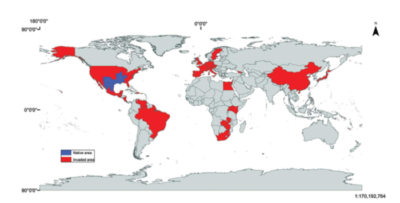 The life cycle is relatively short, around four and a half months from the egg until adult stage. Breeding takes place usually in autumn (second period sometimes in spring). The eggs are fertilized externally, and females will carry them during development (attached to the swimmerets of the tail); hatchlings will remain attached to females through two moults, after that they become free. During this period females look for protection inside the burrows. The diet is omnivorous consisting of plant material, animals (molluscs, insects and fishes), detritus and sediments.
The life cycle is relatively short, around four and a half months from the egg until adult stage. Breeding takes place usually in autumn (second period sometimes in spring). The eggs are fertilized externally, and females will carry them during development (attached to the swimmerets of the tail); hatchlings will remain attached to females through two moults, after that they become free. During this period females look for protection inside the burrows. The diet is omnivorous consisting of plant material, animals (molluscs, insects and fishes), detritus and sediments.
The Red Swamp Crayfish is cultivated and consumed for food in the Southern United States and it has an important economic impact. The introduction in Europe was related to commercial issues; it was introduced in Spain in 1973 and registered for the first time in Portugal in 1979 and its now spread along 11 hydrographic basins. This species is in the top 10 of invasive species which cause more ecologic and economic damage; it is responsible for species extinction and habitat destruction, it has already been identified as having a negative impact on some aquatic plants, invertebrates, amphibians and other species. Although the negative impacts in some species the Red Swamp Crayfish is important in high trophic levels, it is an important food source for the Eurasian Otter (Lutra lutra), for other 3 species of mammals, 6 species of birds and 3 species of fishes in the Mediterranean Region.
Recent studies showed that the climate change is affecting the diet of the Red Swamp Crayfish, consuming more plant material, this can have more negative impacts in aquatic plants and in rice production.
In Portugal exists only one native species of crayfish, the White-clawed Crayfish (Austropotamobius pallipes), but is extinct or almost extinct and has the status of Endangered (EN) according to the IUCN (International Union for the Conservation of Nature). The major threats are habitat loss, suddenly climate changes and competition with invasive species like the Red Swamp Crayfish.
POPPED UP

Family: Smilacaceae
Identification: It is a perennial evergreen climber. The stems are woody and can have spines, can reach 15 metres high; the leaves are leathery, shiny and alternated, heart-shaped with spiny margins and ribs, and with two small tangled tendrils at the base. It is a dioecious species (female and male flowers in different individuals), the flowers are fragrant, small, whitish or greenish and grow in axillary racemes; the fruits are rounded red or black berries. Flowers from April to November.
Habitat and distribution: Shrub lands, Cork oak forests, pine forests, scrublands, hedges and old walls; requires moisture. It occurs in South Europe, Western Asia to India, North and Tropical Africa.
Notes: The roots are used for medicinal purposes as a diuretic and purifying; the berries are toxic for humans but tasty for some birds. In natural habitats it needs other plants to climb; it is used in an ornamental way due to its beautiful berries and to cover old walls (climber).
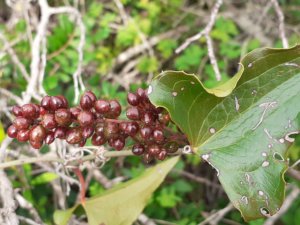
Common Smilax (Smilax aspera) (L. 1753)

DATES TO REMEMBER

4th, 11th, 18th and 25th March – Cruzinha Birdringing display & Moth Talk (10am to 12 am) Book here
19th March – Father’s Day
20th March – Spring Equinox
29th March – The clocks change British Summer Time (forward by one hour)
Thank you for supporting the Friends of A Rocha Portugal

Dr Roy Rodrigues
Av. Do Brasil, Qta das Palmeiras, Lt P2, R/c A, 8500-299 Portimão
(+351) 282180683
royaldente@gmail.com

Sítio da Amoreira, Lote 12,
Alvor, 8500-045 Portimão
(+351) 282412562/ 925433047
www.transfair.com.pt
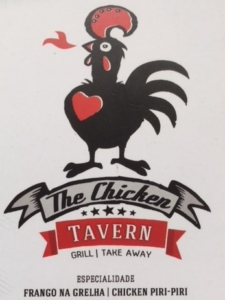
Urbanização Mar e Serra n° 47, Alvor
8500 – 783 Portimão
(+351) 911597735
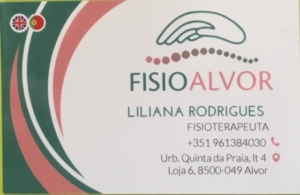
Physiotherapy, Massages (relaxation, sports, therapeutic)
Other therapies
Beauty (manicure, pedicure, hair removal, facials)
Open Monday to Friday
Thought of the month 
“Words that come from the heart are never spoken, they get caught in the throat and can only be read in one’s eyes.”
― José Saramago (Portuguese writer and recipient of the 1998 Nobel Prize in Literature, 1922-2010)

LETS BE GREEN – LETS BE GREEN – LETS BE GREEN 
Little things which make a difference!
Hygiene products
- Avoid using colourful, big and thick paper tissues, use instead cloth handkerchiefs
- Choose cloth nappies
- Avoid using natural sponges
- Choose products with the stamp “no animal testing”
- Use deodorants without aluminium
- Choose natural/organic perfumes and cosmetics without phthalates and parabens (chemical preservatives)
LETS BE GREEN – LETS BE GREEN – LETS BE GREEN
Arenaria Project
Monitoring the distribution and abundance of birds in the beaches and Portuguese coasts.
The Arenaria Project started in 2009/10 and is a partnership of the University Institute (ISPA), the National Natural History and Science Museum of Lisbon University and the Portuguese Society for Bird Study (SPEA). At that time the 1st Census of wintering coastal birds in Portugal was also done. 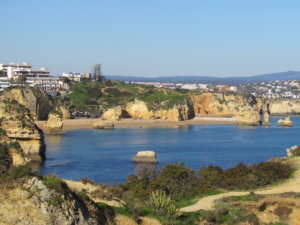
At the beginning of the project the priority was to estimate the distribution and abundance of wintering coastal birds, and an effort was made to monitor the majority of the Portuguese coast. This first data worked as a reference for the interpretation of the future evolution of wintering coastal bird’s populations. For the following years it was important to collect information with a regular standardized method in specified areas to enable the study of the trend of these populations for the medium/long term.
In the winter of 2015/16 and 2016/17 the 2nd Census of wintering coastal birds was done. This project is only possible with the work of many volunteers; A Rocha has been taking part in it since the beginning.
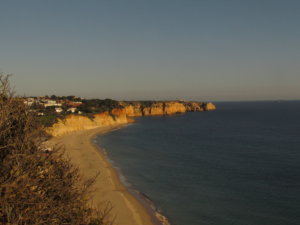 Every year, besides the regular monitoring, the project aims to raise awareness for the conservation of the marine and coastal ecosystems and their biodiversity.
Every year, besides the regular monitoring, the project aims to raise awareness for the conservation of the marine and coastal ecosystems and their biodiversity.
After 10 years of the Arenaria project (2009/18), some interesting results were obtained.
In the year 2018/19, 19 496 birds were recorded from 78 different species; the most common species was the Yellow-legged Gull (Larus michaellis) and the most common wader was the Sanderling (Calidris alba). Although the Sanderling is the most common wader on the Portuguese coast, their numbers have been decreasing in the last 10 years. This species has a global conservation status of “Least Concern” but the global population trend is unknown. In Portugal the major threats are beach disturbance by aquatic activities, people, and dogs without leash.
Sustainability Champions 
Sustainability Champions from around the World– Looking at ways to curb pollution and waste management.
We would like to thank Daniel Hartz, the founder of Sustainability Champions for giving us the permission to share this information.
Karen Jenner- Bay of Fundy Canada
Karen has single-handedly collected trash from beaches for 2 years, and diverts 6350 kilos of plastic waste! 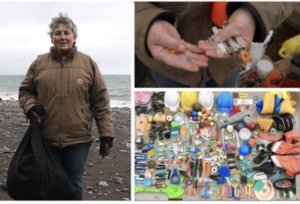
When Karen discovered a plastic grocery bag which she believed to be from the 1970’s which was remarkably intact, it was her ‘WOW moment’ that reaffirmed why it’s so important to find alternatives to plastic. This inspired her to start spending hours each week combing beaches near her farm for trash that the Bay of Fundy’s powerful tides wash ashore.
Three or four times a week she collects and brings the trash back to her home and sorts it into different categories. She counts and weighs the heaps of trash, eventually putting it aside for regular garbage collection. Although she sometimes finds fishing gear, she says between 95 – 99 per cent of what she finds is plastic items.
Some garbage she finds she reuses such as a ladder which was reused as a railing leading to her attic, and plastic scraps used to line her horse stalls.

Bird of the Year 2021 is an Azorean “exclusive”
Monteiro’s Storm Petrel, a small but intrepid bird which nests only in the Azores, was elected Bird of the Year in SPEA’s online vote. Throughout the year, SPEA will celebrate this species and highlight the threats faced by seabirds (the world’s most endangered group of birds) in general and birds that depend on islands in particular. 
“This little bird is incredibly resilient: it can live more than 20 years, spending most of it time at sea. We’re talking about a 50gramme bird that weathers the storms that ravage the Atlantic, year after year,” says Azucena de la Cruz Martín, Coordinator of SPEA Açores.
More info here

Check the website for dates for organised tours
Seabirds at Cape St Vincent – part 2
Let’s move to a group most people do not find appealing: the gulls and 11 species have been seen from Cape St Vincent. Two species can be seen all year round: the Yellow-legged Gull (Larus michahellis), which breeds there and the Lesser Black-backed Gull (Larus fuscus) which is mostly a winter visitor but some young birds stay all year round. The biggest number of Lesser Black-backed Gulls registered was on the 11th of December 2017 with 1925 birds counted in 2 hours. The Mediterranean Gull (Ichthyaetus melanocephalus) has been seen all year round except in May and shows 2 peaks: one at the beginning of April and one at the beginning of November. The maximum was recorded on the 4th of December 2020 with 786 birds counted in 2 hours. The Audouin’s Gull, (Ichthyaetus audouinii) once one of the rarest species of gulls in Europe, has experienced an expansion these last few years. It was seen for the first time at the Cape in September 2008 and has been recorded every month except July. It also shows 2 peaks, but both in Spring: one at the end of March and another at the end of April. The Audouin’s Gull still remains a species with small number in this part of the Algarve, the maximum seen is only 7 birds on the 31st of March 2017 in almost 2 hours of counting. The Great Black-backed Gull (Larus marinus) also shows-up in small number and the maximum reported were 2 birds on the 20th of November 2015. This species has been recorded in January, February, May and between September and the beginning of December.
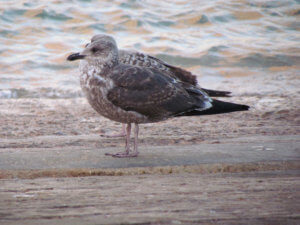
Black-backed Gull (Larus fuscus)
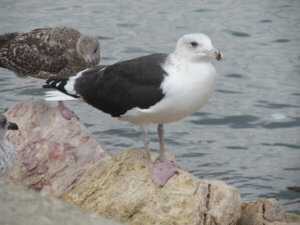
Great Black-backed Gull (Larus marinus)

Yellow-legged Gull (Larus michahellis)
Two species, the Black-headed Gull (Chroicocephalus ridibundus) and the Kittiwake (Rissa tridactyla) have been reported only in autumn and winter. The Black-headed Gull has been recorded between July and the end of April, this species shows 3 peaks: at the beginning of February, beginning of August and mid-December. The maximum was seen on the 27th of December 1988 with 70 birds. The Kittiwakes are seen in fewer months than the Black-headed Gull. It is present between the end of October and mid-March and has 2 peaks, one at the beginning of January and another one at the beginning of November. On the 25th of December 2013, 50 birds were recorded passing at the Cape.
Four species have few sightings. The Mew Gull (Larus canus) was seen 5 times, in January, February, Septemeber, October and November, always one bird. The Little Gull (Hydrocoloeus minutus) was spotted 3 times: 3 on the 21st of October 2014, 1 on the 29th of October 2018 and 2 on the 4th of December 2020. The Sabine’s Gull (Xema sabini), a rare species in Portugal, was seen twice during the autumn: 5 on the 22nd of November 2011 and 1 on the 1st of December 2019. Finally, the Slender-billed Gull (Chroicocephalus genei) was recorded once with one bird on the 31st of August 2019.
Six species of terns have been seen from the Cape. The most common is the Sandwich Tern (Thalasseus sandvicensis), not breeding in the area but seen all year round. The peak is mid-September and the maximum seen were 222 birds on the 30th of September 2013 in 1h30. The Common Tern (Sterna hirundo) has been recorded between mid-August and April with a peak at the end of August. The maximum was recorded on the 2nd of September 2012 with 27 birds passing in 1 hour. The Arctic Tern (Sterna paradisea) is very similar to the Common Tern and these 2 species can be difficult to tell apart when seen at a distance. This could explain why it has only been recorded between mid-August and the beginning of November with a peak at the end of September. The maximum recorded were 16 birds on the 30th of September 2007. The biggest Tern in Europe is the Caspian Tern (Hydroprogne caspia), a common wintering species along the coast of the Algarve. However, this species has only been seen between the end of September and mid-November at Cape St Vincent with a peak at the end of September and a maximum of 8 birds passing on the 23rd of September 2014. The Little Tern (Sternula albifrons) is another common species along the coast but only in spring and summer when it comes to breed. At Cape St Vincent, it has been recorded in September and the beginning of November in low numbers, the maximum was only 3 birds on the 21st of September 2014. This species is more common at the beginning of September. The terns belonging to the genera Chlidonias are usually referred to as “marsh terns” and only one species of this group has been seen at Cape St Vincent: the Black Tern (Chlidonias niger). It is present between mid-August and mid-October. It peaks at the end of September and the maximum recorded was on the 30th of September 2013 with 13 birds.
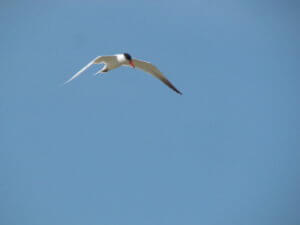
Caspian Tern (Hydroprogne caspia)

Sandwich Tern (Thalasseus sandvicensis)
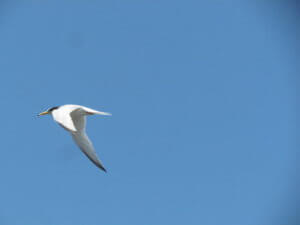
Little Tern (Sternula albifrons)
The Storm-Petrels are the smallest seabirds. They are usually seen far from the coast but can sometimes be blown by the wind closer to the shore. The most common, and well known by the A Rocha Portugal team, is the European Storm-Petrel (Hydrobates pelagicus) seen in September and October (but only 7 times). The peak is during the first half of October and the maximum recorded were 14 birds on the 5th of October 2016. The Leach’s Storm-Petrel (Oceanodroma leucorhoa) has been seen 4 times between October and December (twice in October and once in November and December). The maximum seen were 15 birds on the 4th of November 2011 in 1 hour. Many birders come to the Sagres area looking for the Wilson’s Storm-Petrel (Oceanites oceanicus). While it is fairly easy to see from a boat, it has only been seen twice from Cape St Vincent: 2 on the 14th of October 2012 and 1 on the 16th of October 2017. Finally, one White-faced Storm-Petrel (Pelagodroma marina) was spotted on the 25th of October 2013.
The Shearwaters belong to the same group of birds as the Storm-Petrels (the tubenose) but are bigger. Five species have been seen from Cape St Vincent. The Balearic Shearwater (Puffinus mauretanicus), one of the most threatened seabirds in Europe, has been recorded all year. It peaks at the end of September and the maximum were 340 birds seen in almost 1 hour on the 30th of September 2012. The Cory’s Shearwater (Calonectris borealis) has been seen all year except in January. This species can sometimes be seen from the coast resting on water, forming big rafts. The peak is mid-October and the maximum was recorded on the 21st of October 2012 during a 3 hour count when 1336 birds were spotted. The Manx Shearwater (Puffinus puffinus), quite similar to the Balearic Shearwater has been see in February, May, June and between August and the beginning of December. It shows 2 peaks, both in the autumn: mid-August and mid-September. The maximum was recorded on the 2nd of September 2016 with 21 birds. The Sooty Shearwater (Ardenna grisea) has also been recorded in spring and autumn but only in April and between July and November. The peak is during the 2nd half of September and the maximum recorded was on the 7th of October 2009 with 73 birds. The last species is the Great Shearwater (Ardenna gravis), only seen between July and mid-December. This species peaks during the first half of September and the maximum recorded were 7 birds on the 1st of September 2012 during a 3 hour count.
Only one species of Loon has been seen at Cape St Vincent: the Common Loon (Gavia immer), recorded 4 times, always a single bird, on the 22nd of November 2011, 12th of January 2013 and 21st and 30th of November 2019.
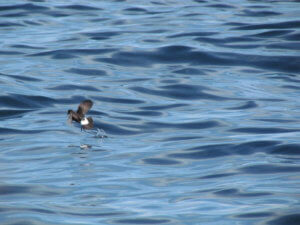
European Storm-Petrel (Hydrobates pelagicus)
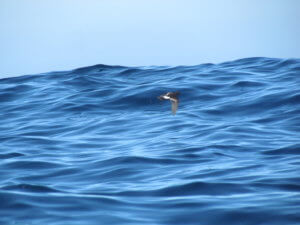
Wilson’s Storm-Petrel (Oceanites oceanicus)
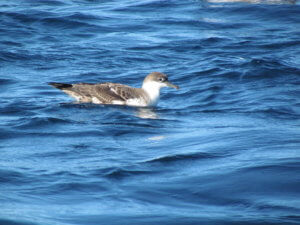
Great Shearwater (Ardenna gravis)

Balearic Shearwater (Puffinus mauretanicus)
The Gannet (Morus bassanus) does not breed in Portugal (the nearest colonies are in France) but can be seen all year round. It is more abundant in autumn with a peak at the end of October. On the 30th of October 2010, during a 1 hour count, 8562 Gannets were recorded, the maximum so far. The Brown Booby (Sula leucogaster) is much rarer than the Gannet and breeds in the tropical waters of the Atlantic and Pacific oceans. It was reported twice at Cape St Vincent, on the 5th of October 2017 (2 birds) and on the 1st of September 2020 (1 bird).
Shags (Phalacrocorax aristotelis) breed on the cliffs around Sagres and can be seen all year round. The maximum recorded were 16 birds on the 28th of June 2012. The Cormorant (Phalacrocorax carbo) is quite similar to the Shag and can be seen almost all year since it has never been recorded in June and August. The peak is at the beginning of February and the maximum recorded were 13 birds on the 8th of February 2016.
While seawatching at the Cape, other aquatic birds, such as Herons and Egrets sometimes appear. According to ebird, the most common is probably the Cattle Egrett (Bulbucus ibis) seen every month except in February and August. The peak is during the second half of March and the maximum reported were 75 birds on the 27th of December 1988. Another small white Heron, the Little Egret (Egretta garzetta) has been recorded 9 months of the year: between February and April and between June and November. This species peaks mid-September and the maximum reported was on the 9th of October 2016 with 22 birds. The Grey Heron (Ardea cinerea) has been reported 6 months of the year, in March and April and between mid-August and the end of November. The peak is at the beginning of September and the maximum registered 9 birds on the 2nd of September 2012. The other species have only been recorded a few times. The Spoonbill (Platalea leucorodia) was spotted 3 times, always in flocks and all the sightings refer to October 2017: 16 on the 6th, 20 on the 7th and 17 on the 8th. Then, there are 2 sightings of Glossy Ibis (Plegadis falcinellus): 3 on the 7th of September 2018 and 21 on the 5th of October 2020. Finally, the Great White Egret (Ardea alba), a species more and more common in the Algarve has been seen only once, on the 5th of October 2020 (1 bird).
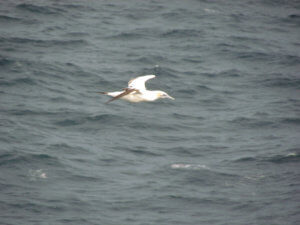
Gannet (Morus bassanus)
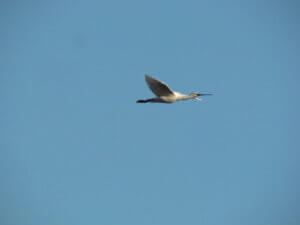
Spoonbill (Platalea leucorodia)
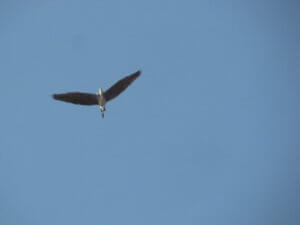
Grey Heron (Ardea cinerea)
Photos and text by Guillaume Réthoré
If you have any queries please do not hesitate to contact us:
friends.arpt@arocha.org
Visit us on our open day: Thursdays from 10 to 12:00 am
See map: https://arocha.pt/en/contact-us/
GPS coordinates
37°08’39.8″N (37.1444) 8°36’29.2″W (-8.6081)
(+351) 282 968 380
Thank you for supporting us!
Hope to see you soon!







